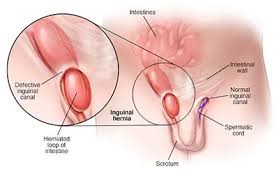Repair of strangulated hernia or strangulation; any type
Fatty tissue or part of the small intestine presses on the weak abdominal muscle. The muscles around the tissue then tighten, cutting off blood flow to the small intestine. This blockage in the small intestine can lead to perforation, shock, or gangrene (tissue death), which can be fatal. Strangulated hernias can be congenital and can occur at any age. If the muscle tissue in the abdomen is weak, it has the potential to become a hernia, causing a blockage in that part of the muscle tissue. Surgery is the only treatment for this type of hernia. It is best to have surgery early to prevent further damage to the tissue. The surgery involves two stages. First, the surgeon tries to push the hernia back into the abdominal cavity by applying pressure. If necessary, the doctor removes the damaged tissue and repairs the hernia with tissue or artificial mesh to prevent recurrence or other problems. Depending on the treatment plan, general or local anesthesia may be required. Open surgery is preferred for strangulated hernias. Laparoscopic surgical methods have also been tried, and initial results have been successful. However, researchers believe that more studies are needed on laparoscopic surgery for this type of hernia, due to the risk of injury.
 
|